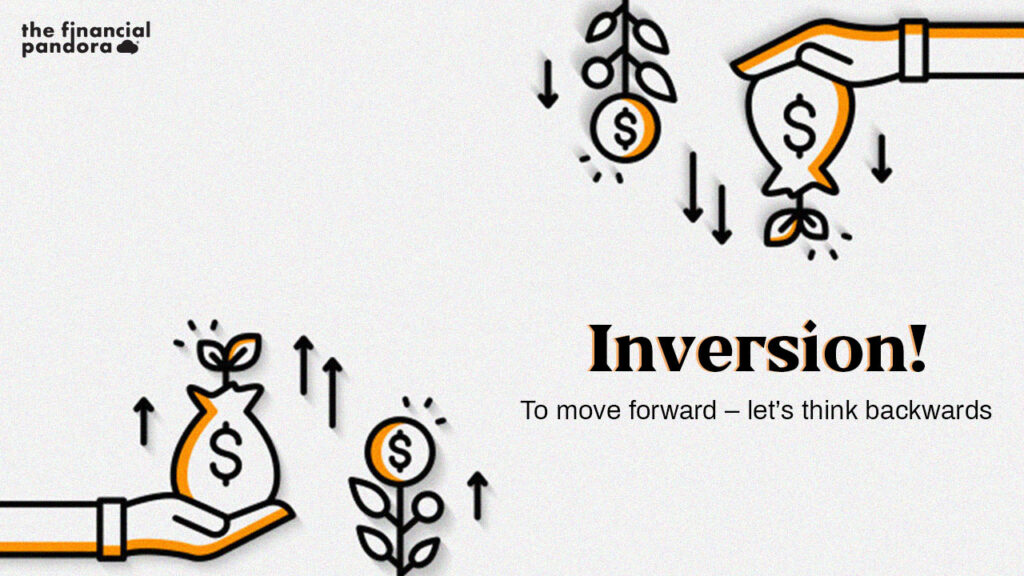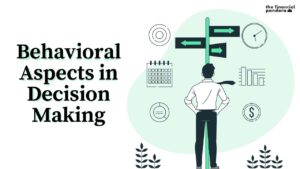Let’s travel back in time and think about this – As a child, many of us touched the newspaper just for a couple of things. First – to read about the sports column and second – to solve the puzzles. One particular puzzle that most of us attempted to solve was the ‘maze puzzle’. Be it to make the monkey reach his banana or the scooter reach the gas station. And let’s be honest, when we couldn’t reach the destination from the start point, we reverse tracked the maze – and voila, the maze was solved. Unconsciously, we used the principle of ‘Inversion’ here. The legendary Charlie Munger said “It really works to tackle much of life by inversion where you just twist the thing around backwards and answer it that way. All kinds of problems that look so difficult, if you turn them around, they are quickly solved.”
What is Inversion?
Inversion means solving a problem backward. Quoting Nimesh Chandan, “If forward thinking is about ‘trying to be smart’, inversion is about ‘trying not to be stupid.” Inverting the problem is a technique used by many intellectuals across the globe to answer questions on almost everything and not look stupid.
Let’s take an example – if a company wants to improve its productivity, instead of answering “How to improve the productivity,” the company may answer to, “Doing which activities would reduce the productivity.” All such activities would be avoided. Organizations often backtrack the problems during the pilot study itself. All possible things that could go wrong in the project are answered upfront and worked upon, so that they are avoided.
Inversion - In Investing
We often talk about investments, and the talk that generally follows it is the returns the investments have generated. Our goal in investing is to generate maximum returns and find ‘multi-baggers’. But at a primitive stage, what we do not anticipate or often avoid to think is the risk associated with those investments. For example, say there is a 51% probability that our investment would generate positive returns. This probability makes us believe that our investment is good and that we would achieve returns on it. However, we should also consider the fact that there is also a 49% probability of dimunition in value of capital invested. Understanding the potential risks associated with our investments beforehand can definitely help us avoid “fraction baggers” (opposite of multi-bagger). Hence, instead of starting our investment research with the question “Which stock(s) can earn us a 10x return”, start with “which stock(s) would sink our entire capital.”
It’s quite intuitive that following this approach leads to a virtuous circle. It would help reduce the chances of failure and in turn increase the likelihood of success. Majority of people support their initial assumption by doing research, but inversion theory says, take the initial hypothesis and try to disapprove it. By doing so, we will filter out a major chunk of stocks which we ought to avoid.
Now the next obvious question is – how to reject a stock or narrow down the security universe. Let’s quickly take a look at some of the factors or traits of the worst performers:
- Companies with high financial leverage (high debt, high debt/equity ratio)
- Companies with profitability ratios consistently lower than industry; stocks trading at unjustifiable PE ratio
- Companies consistently having a free cash flow or cash flow from operations significantly lower than net income
- Companies where the management has a poor track record to deliver on their guidance, i.e. consistent overestimation by the management
- Companies where management has ongoing litigations or have past litigations/fraud history
- Companies where the stock price is increasing only based on stories, with no support from its fundamentals
- Companies with subdued revenue growth, high working capital cycle, low return ratios compared to their peers
By performing this exercise, we would be able to remove the worst stocks from the universe, which can possibly help reduce the losses, preserve our capital, and allocate the capital in better stocks or alternate assets. It can be argued that these pointers do form part of an analyst’s due diligence and stock picking process. However, one often tends to focus on the positives more than the lagging indicators. Decisions are often taken in the midst of “missing the bus” without considering factors that might be a deterrent to our returns. One can also have a detailed checklist for dos and don’ts before investing in any particular stock.
Let us consider Nestle which has a Price to Earnings Ratio (PE) of 73. We expect the stock to double in the next 5 years. Given its track record of tripling in the last 3 years, it would be a fair bet. Let us rationalize that in 5 years, the PE of Nestle would converge with the broader market PE for FMCG companies of 40x. Hence, for the stock to double in next 5 years with an average PE of 40, the earnings would have to grow at a CAGR of ~30%. Now, even for a company as consistent as Nestle, this becomes difficult, if not impossible. Applying the inversion theory, we can validate that certain outcomes might be difficult to achieve.
It may be noted that no process or method can be full proof and guarantee a good return. We often lose confidence in the process/method if those processes do not give us the desired return. Consistent changes in process would affect our long-term returns. Hence, discipline plays a significant role in investing – develop a process and follow the same diligently. In the case of new developments, modify the process by incorporating the new information, and follow the same. Estimate the probability of success and failure, and if the returns are within the probability range, do not change the process.
Inversion – In Life
Today, in the name of standard of living, materialism has taken a front seat. The world now goes for the gold under the notion that some is good, more is better, and too much is just right. Humans are troubled by the rush of desires and worldly pleasures, filled with the troubling sense of ego with mine and thine. A loud cry for paradigm shift is to be made with the virtues of co-existence, interdependence, sufficiency, and compassion. On his 151st birth anniversary, we would like to remember Mahatma Gandhi and his list of 7 social sins – Politics without principles, wealth without work, pleasure without conscience, knowledge without character, commerce without morality, science without humanity, and worship without sacrifice. Amazed how these sins have gradually become a part of our lives and that it may no longer appear to be sins. Gandhi Ji did say, “the future depends on what you do today”. So, decide today!
Reminds me of a shloka from Shrimad Bhagavad Gita, where the supreme reality is a night of confusion and darkness for the ignorant, but the man with steady wisdom is fully awake. Inversely, a world of material objects, greediness, desires and worldly pleasures is a day to the ignorant and a nightmare for the wise!
या निशा सर्वभूतानां तस्यां जागर्ति संयमी |
यस्यां जाग्रति भूतानि सा निशा पश्यतो मुने: // २. ६ ९//
yaanishaa sarvabhootaanaam tasyam jaagarti samyamee
yasyaam jaagrati bhootani saa nishaa pashyato muneh // 2.69 //
Here’s a video demonstrating the power of inversion. Enjoy and happy reading!
Follow Us @




